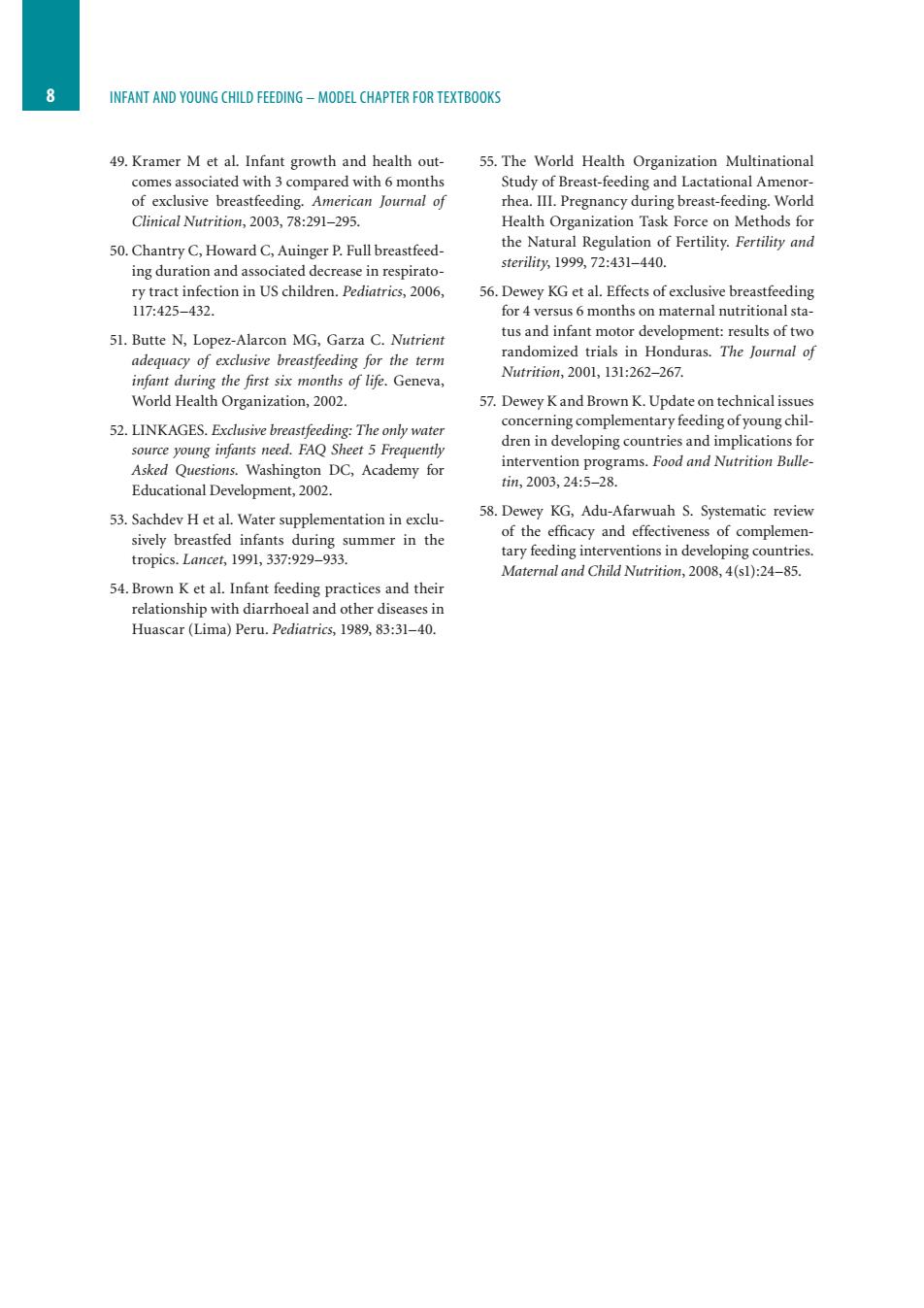正在加载图片...

8 INFANT AND YOUNG CHILD FEEDING-MODEL CHAPTER FOR TEXTBOOKS 49.Kramer M et al.Infant growth and health out- 55.The World Health Organization Multinational comes associated with 3 compared with 6 months Study of Breast-feeding and Lactational Amenor- of exclusive breastfeeding.American Journal of rhea.III.Pregnancy during breast-feeding.World Clinical Nutrition,2003,78:291-295. Health Organization Task Force on Methods for 50.Chantry C,Howard C,Auinger P.Full breastfeed- the Natural Regulation of Fertility.Fertility and sterility,1999,72:431-440. ing duration and associated decrease in respirato- ry tract infection in US children.Pediatrics,2006, 56.Dewey KG et al.Effects of exclusive breastfeeding 117:425-432. for 4 versus 6 months on maternal nutritional sta- 51.Butte N,Lopez-Alarcon MG,Garza C.Nutrient tus and infant motor development:results of two adequacy of exclusive breastfeeding for the term randomized trials in Honduras.The Journal of utrition,2001,131:262-267. infant during the first six months of life.Geneva, World Health Organization,2002. 57.Dewey K and Brown K.Update on technical issues concerning complementary feeding of young chil- 52.LINKAGES.Exclusive breastfeeding:The only water source young infants need.FAQ Sheet 5 Frequently dren in developing countries and implications for Asked Questions.Washington DC,Academy for intervention programs.Food and Nutrition Bulle- Educational Development,2002. tim,2003,24:5-28 53.Sachdev H et al.Water supplementation in exclu- 58.Dewey KG,Adu-Afarwuah S.Systematic review sively breastfed infants during summer in the of the efficacy and effectiveness of complemen- tropics.Lancet,1991,337:929-933. tary feeding interventions in developing countries. Maternal and Child Nutrition,2008,4(s1):24-85. 54.Brown K et al.Infant feeding practices and their relationship with diarrhoeal and other diseases in Huascar(Lima)Peru.Pediatrics,1989,83:31-40.8 Infant and Young Child Feeding – Model Chapter for textbooks 49. Kramer M et al. Infant growth and health outcomes associated with 3 compared with 6 months of exclusive breastfeeding. American Journal of Clinical Nutrition, 2003, 78:291–295. 50. Chantry C, Howard C, Auinger P. Full breastfeeding duration and associated decrease in respiratory tract infection in US children. Pediatrics, 2006, 117:425–432. 51. Butte N, Lopez-Alarcon MG, Garza C. Nutrient adequacy of exclusive breastfeeding for the term infant during the first six months of life. Geneva, World Health Organization, 2002. 52. LINKAGES. Exclusive breastfeeding: The only water source young infants need. FAQ Sheet 5 Frequently Asked Questions. Washington DC, Academy for Educational Development, 2002. 53. Sachdev H et al. Water supplementation in exclusively breastfed infants during summer in the tropics. Lancet, 1991, 337:929–933. 54. Brown K et al. Infant feeding practices and their relationship with diarrhoeal and other diseases in Huascar (Lima) Peru. Pediatrics, 1989, 83:31–40. 55. The World Health Organization Multinational Study of Breast-feeding and Lactational Amenorrhea. III. Pregnancy during breast-feeding. World Health Organization Task Force on Methods for the Natural Regulation of Fertility. Fertility and sterility, 1999, 72:431–440. 56. Dewey KG et al. Effects of exclusive breastfeeding for 4 versus 6 months on maternal nutritional status and infant motor development: results of two randomized trials in Honduras. The Journal of Nutrition, 2001, 131:262–267. 57. Dewey K and Brown K. Update on technical issues concerning complementary feeding of young children in developing countries and implications for intervention programs. Food and Nutrition Bulletin, 2003, 24:5–28. 58. Dewey KG, Adu-Afarwuah S. Systematic review of the efficacy and effectiveness of complementary feeding interventions in developing countries. Maternal and Child Nutrition, 2008, 4(s1):24–85